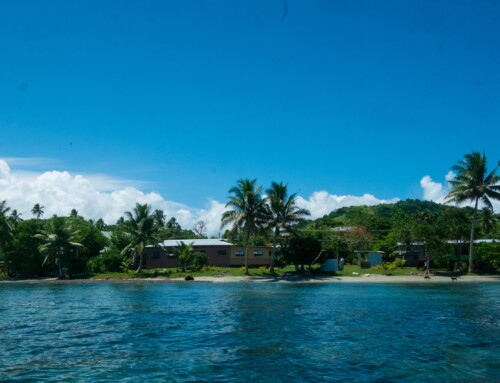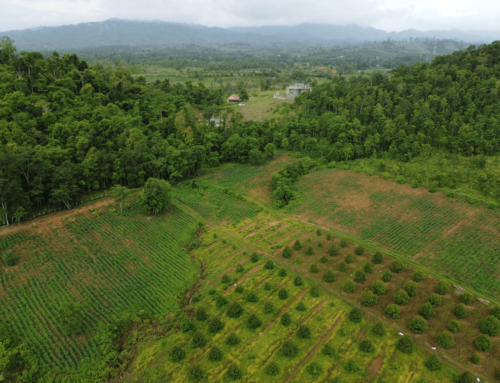BACKGROUND
The Mekong is one of the world’s great rivers. It is the third-largest river in Asia and the largest river in Southeast Asia. The source of the Mekong is located on the high Tibetan plateau in China. As the river flows downstream, it is joined by tributaries from Myanmar, Lao PDR, Thailand and Cambodia, eventually reaching its delta in Vietnam.
On average, every year about 460 billion cubic metres of water flows from the Mekong into Vietnam’s Mekong Delta Region.[1] However, despite receiving this enormous amount of water every year, the delta’s population of about 20 million people face many challenges in obtaining fresh water that is suitable for drinking and other domestic purposes. There are also concerns that the water insecurity these communities currently face could significantly worsen in the future due to climate change and other developments in the Mekong Basin. The delta is Vietnam’s main agricultural centre, so water insecurities for communities living here could have implications for Vietnam’s food security and economy at a national level.
Due to these concerns, the World Bank, with support from the Global Facility for Disaster Reduction and Recovery and the Global Water Security and Sanitation Partnership contracted ICEM to undertake a vulnerability assessment for rural water supply systems in the Mekong Delta region under two steps, as discussed below. The first step was to assess the vulnerability of the delta’s rural water supply systems, and the potential effects of climate change and regional development on these vulnerabilities in the future. The second step was to recommend ways to increase the resilience of water supply systems to these vulnerabilities.
STEP 1: VULNERABILITY ASSESSMENT

Figure 1: Known rural drinking water systems in the Mekong Delta region

Figure 2: Saline intrusion hazards under current, 2030, and 2050 conditions
ICEM’s team started the work by holding discussions with the Ministry of Agriculture and Rural Development (MARD) and agencies in each of the delta region’s 13 provinces. This allowed the team to establish a baseline and trends for the problems each of the provinces are facing. It was also important to review and document how each province determines the suitability of water in canals, streams, rivers, and groundwater as drinking water sources.
Building on this initial review, the ICEM team developed a source assessment methodology (SAM) for use by all local authorities in meeting their legal requirements for drinking water resource assessment, in ways consistent with international best practices.
While the SAM was being developed, the ICEM team continued to gather data and identify potential drinking water security issues in the delta in consultation with MARD, local agencies and other stakeholders. The data and information were integrated into a series of maps on a wide range of spatially explicit parameters, including infrastructure, population distribution, locations of drinking water systems, and groundwater and surface water sources. For example, Figure 1 identifies the location of drinking water systems in the Delta and Figure 2 shows trends in saline intrusion from 2016 to 2050 under various climate change scenarios.

Figure 3: Overlaying maps to identify climate vulnerability hotspot
The ICEM team modelled drinking water system vulnerability to salinity, flooding, and pollution for current conditions and for two climate change scenarios until 2050. These layers were overlaid to determine hotspots for drinking water vulnerability (Figure 3).
The vulnerability assessment found that groundwater is the main water source for most rural communities. They prefer groundwater because in most areas it is relatively clean due to natural filtration. It is also a convenient water source because for most of the delta region, people can tap into freshwater aquifers directly where they need it, using wells and boreholes. This direct access is easier than constructing pipelines to pump water from nearby rivers and canals. However, groundwater is increasingly used by the expanding industries, urban centres and agriculture at a rate much faster than it can be replaced by nature.
Two problems emerge when groundwater is used faster than it can be replaced. First, the depth of the groundwater table can fall below the limits of existing domestic and local boreholes. Costly infrastructure investments, such as installing more powerful pumps and drilling deeper boreholes are then needed to access groundwater.
Second, as the water table lowers, land subsidence occurs. Subsidence can potentially cause damage to urban and rural infrastructure such as buildings, roads and subsurface utilities such as water supply pipes. Furthermore, the ICEM team’s assessment found that subsidence will lower land levels in many coastal areas of the delta by enough to make coastal flooding more widespread and more severe in the wet season, and saline intrusions from seawater more widespread and more severe during the dry season.
Wet season flooding can cause significant problems for water supply systems by disrupting the operation of infrastructure such as pump systems. Furthermore, flood waters tend to have high concentrations of sediments and other pollutants which may make water in canals and rivers difficult to treat for drinking water system operators. Flooding will also become worse in the future as sea levels rise due to climate change.

Figure 4: Existing and future hydropower dams in the Mekong River Basin
In the dry season, saline intrusions can damage ecosystems and infrastructure, and make water unsuitable for domestic, industrial and agriculture uses. Salinization will be worsened by sea level rise due to climate change and is exacerbated by the erosion of waterways due to sediment losses from the construction of upstream dams (Figure 4) and locally from sand mining.
If drinking water in becomes less accessible and more expensive to source and treat, people in some communities in the delta may decide they would prefer to relocate to other areas. That internal migration from the delta to cities has already begun.
The outcome of the vulnerability assessment was a series of maps showing the current vulnerability of drinking water systems, and future vulnerability by 2030 and 2050 for hazards of salinity, pollution and flooding (Figure 5) in the hypothetical case that no actions to reduce these vulnerabilities would be taken. To develop these maps the team considered the cumulative effects of hazards such as groundwater depletion, land subsidence, erosion, droughts, sea level rise and upstream dam developments, as well as the sensitivities of communities to these hazards due to factors such as poverty, access to education and so on.
It was found that there are significant concerns for some provinces in the delta now, such as Bac Lieu and Ben Tre which already face very high to extreme vulnerability due to salinity and pollution hazards. Into the future, these vulnerabilities worsen significantly across most of the delta unless actions to reduce them are taken.

Figure 5: Current and future vulnerabilities of drinking water systems in the Mekong Delta Region
STEP 2: HOW CAN THE VULNERABILITY OF DRINKING WATER SYSTEMS BE REDUCED IN THE MEKONG DELTA?
From the ICEM teams vulnerability assessment under step 1, it is clear that interventions to increase the resilience of rural water supply systems to climate-related threats will be critical for the future well-being of many of the Mekong delta’s communities. Working with government and local stakeholders, the ICEM team developed several practical measures to help these communities.
The first practical measure recommended is for towns across the Mekong Delta to interlink their water supply networks through regional bulk water supply pipelines. These bulk water supply lines can facilitate the transfer of water from regions with ample freshwater resources to areas where access to freshwater is limited. However, bulk water supply lines will be costly to construct and require further costs for their ongoing operations and maintenance.
The ICEM team also considered it is important to make recommendations that can be implemented at a lower cost with local resources. Household rooftop rainwater collection systems (Figure 6) were identified as systems that can be set up relatively easily with low construction costs, little need to bring in outside materials or experts, and have minimal operating costs. Rainwater harvesting is also possible at larger scales for village and district level water supply schemes, such as the recently commissioned An Minh Rural Water Supply System (Figure 7) Equally, important, improving the effectiveness of sewerage and grey water sanitation systems would reduce surface water pollution and improve the quality of available freshwater that is used as a source for drinking water systems.

Figure 6: A typical household rainwater harvesting system in the Mekong Delta Region (Source: ICEM)

Figure 7: The An Minh rainwater harvesting and rural water supply system in Kien Giang Province (Source: ICEM)
Nature-based Solutions (NbS) are highly effective either alone or as a complement to hard infrastructure in building resilience to climate change. NbS help restore and maintain ecosystem services and bring significant co-benefits to communities such as improved fish habitat or nature water filtration. NbS that the team identified included vegetated buffer strips planted to stabilise riverbanks to reduce soil loss, and pollution in waterways, and constructed wetlands upstream of drinking water system intakes to improve water quality and provide more water during low flow periods (Figure 8).

 Figure 8: Riverbank vegetation for erosion protection on a small stream in Northern Vietnam (left), and a typical constructed wetland (right) Sources: ICEM (left), https://fwrinformationcentre.co.uk/html/wetlands—overview.html (right)
Figure 8: Riverbank vegetation for erosion protection on a small stream in Northern Vietnam (left), and a typical constructed wetland (right) Sources: ICEM (left), https://fwrinformationcentre.co.uk/html/wetlands—overview.html (right)
In saline and brackish areas, planting mangroves and linear wetlands would help to maintain soil health, reduce flooding and pollution, and limit the inland reach of salinity. Locals can identify plants to use for these projects that are valuable to them as food sources and for material uses like traditional crafts and producing souvenirs for sale to tourists (Figure 9).

Figure 9: A section of mangrove forest in An Minh District, Kien Giang Province (Source: ICEM)
These practical solutions would need to be supported by policy changes. Comprehensive adoption of Integrated Water Resource Management (IWRM) approaches is needed to ensure effective coordination of domestic, agricultural, and industrial water use and consideration of current and future water availability and climate hazards. One focus of IWRM in the delta is the salinity balance and discharge of wastewater from aquaculture systems, as poor management will affect other nearby fresh water sources.
How wastewater is treated and discharged must also be addressed as part of an overall IWRM approach. Discharging polluted water affects downstream water quality and users, especially for the most vulnerable farming communities and fishers. Water allocations for environmental management purposes also need to be addressed.
In March 2023, The United Nations hosted a global conference on water. Vietnam pledged to develop policies to manage river basins by 2025 and to ensure every household will have access to clean drinking water by 2030. Through IWRM, communities and government agencies can work together to overcome the growing climate challenges.
The recommendations and implementation plans ICEM developed are helping build resiliency in the Mekong River Delta and secure safe drinking water. On a larger scope, the World Bank is applying the SAM to assess water sources in other parts of Vietnam and in neighbouring countries such as Lao PDR and Cambodia.
With coordination and cooperation, everyone can have safe water to drink.
_____________________________________
[1] MRC. 2005. Overview of the Hydrology of the Mekong Basin. Mekong River Commission, Vientiane, November 73pp







Leave A Comment